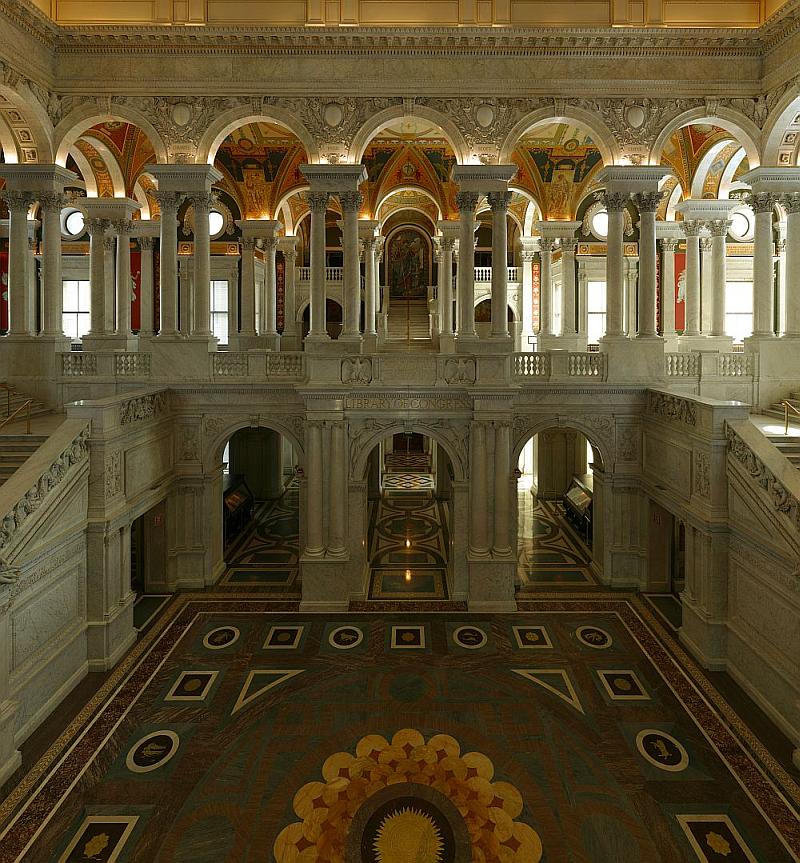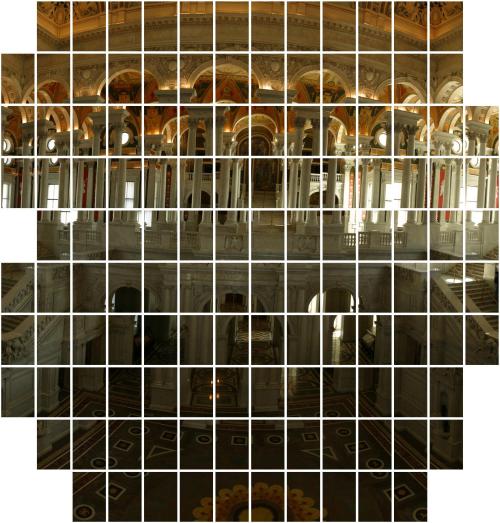Nov 28, 2003: Since I originally wrote this essay, I've created an even higher resolution image. You might want to read about it as well.
This page contains some examples to illustrate the level of detail that I am able to capture by creating stitched images. The image below shows a picture of the Great Hall in the Library of Congress in Washington, DC. It was created by stitching 129 images together--each of the 129 images has a size of 3072x2048 pixels. The final stitched image has dimensions of 25930x27985, or about 725 megapixels (0.73 gigapixel). This is my largest stitched image to date (November 2003).

Resized version of 725 megapixel image after stitching
In comparison, the best consumer-level digital cameras (as of late 2003) capture about 5-6 megapixels, although professional cameras that capture 11-14 megapixels are available for between $5,000 and $8,000. How does this compare to 35mm film? There is a lot of debate as to exactly how much detail is captured by 35mm film, but most people seem to agree that a 6 megapixel digital camera like the Canon D60 can produce images that rival images taken with a 35mm camera. What digital cameras lack in absolute resolution, they make up for in lack of distracting film grain.

129 component images before stitching
In fact, digital cameras produce such "smooth" images that some professional photographers have already given up their medium format cameras in favor of 11 megapixel digital cameras. Here's what Michael Reichman has to say about the 11 megapixel Canon 1DS, compared to medium format film cameras:
The 1Ds also fares very well against medium format. Is it sharper than 645? No, not quite, but really very close. When you add in the extremely low noise of the images compared to scanned film, and add in all of the cost and workflow advantages of shooting digital over shooting and scanning film, in my opinion the 1Ds is to be preferred. I'll gladly take the huge reduction in noise (grain) over slightly lower overall resolution any day of the week.
So, if an 11 megapixel image compares favorably to medium format, how does a 50, 100 or 725 megapixel image compare? Very well! In fact, I'd say that there is no comparison.
Below are cropped portions from the center of the image above. They are designed to simulate the amount of detail that can be captured by digital cameras with varying resolutions. To create these images, an area from the middle of the original image was cropped, resized to the size that would have been captured by a camera with the reported resolution (e.g. 6 megapixel camera) using Photoshop's bicubic interpolation, and then resampled to the same size of 200x200 pixels to facilitate comparison. (If anything, this process errs on the side of caution, making the simulated crops appear sharper than they would from a real camera.)

Unresized crop from original 725 megapixel image |
||
 50 Megapixel camera |
 20 Megapixel camera |
 11 Megapixel camera |
 6 Megapixel camera |
 3 Megapixel camera |
 2 Megapixel camera |